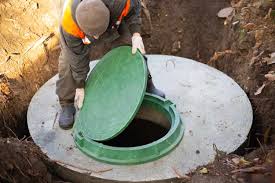How to check if a septic tank is full: By visually inspecting the liquid level, scum and sludge layers, and measuring the depth using a septic tank probe or long pole. Maintaining a properly functioning septic tank is crucial for the overall health and hygiene of your home. Regular maintenance ensures the efficient disposal of wastewater and prevents costly repairs or replacements. One key aspect of septic tank maintenance is knowing when it’s time to pump out the tank. In this comprehensive guide, we will walk you through the process of checking if your septic tank is full. By understanding the signs of a full septic tank and performing a visual inspection, you can take proactive measures to keep your septic system in top shape.
Understanding the Septic Tank System
Before diving into the inspection process, it’s essential to have a basic understanding of how a septic tank system works. A septic tank is an underground container that collects and decomposes wastewater from your home. It consists of several components, including the tank itself, inlet and outlet pipes, baffles, and a drain field. The tank holds the wastewater long enough for solids to settle at the bottom (forming sludge) and oils, fats, and greases to float to the top (forming scum). The clarified liquid, known as effluent, flows into the drain field where it gets further treated by the soil.
Signs of a Full Septic Tank
Identifying the signs of a full septic tank is the first step in determining if it’s time for pumping. Some common signs include slow drains, backed-up plumbing fixtures, foul odors inside and outside the house, lush and green patches in the drain field, gurgling sounds in the plumbing system, and sewage backup or overflow. If you notice any of these signs, it’s essential to investigate further to determine the cause.
Preparations Before Checking the Septic Tank
Before beginning the inspection process, it’s crucial to take certain precautions and gather the necessary tools. First and foremost, ensure your personal safety by wearing gloves and protective clothing. You’ll need a flashlight, a septic tank probe or a long pole, and a shovel for accessing the tank. Additionally, locate the septic tank and its access points. You can refer to your property’s septic system diagram or consult a professional if you’re unsure.
Visual Inspection of the Septic Tank
Start by safely removing the access covers of the septic tank. Using a flashlight, carefully assess the tank’s contents. Observe the liquid level inside the tank, which should ideally be around 8 to 12 inches below the top of the tank. If the liquid level is too close to the top or overflowing, it’s a clear indication that your septic tank needs pumping. Next, examine the scum and sludge layers. The scum layer, composed of oils and fats, should be floating on top, while the sludge layer, made up of solid waste, should settle at the bottom. If these layers are approaching the outlet pipe or baffles, it’s a sign that the tank requires pumping.
Measuring the Septic Tank’s Depth
To get a more accurate understanding of the tank’s contents, you can measure its depth using a septic tank probe or a long pole. Insert the probe into the tank through the access point and note the depth at which it encounters resistance. This resistance indicates the level of sludge and scum in the tank. Measure both the sludge and scum layers separately. If the combined depth of sludge and scum exceeds one-third of the total liquid depth, it’s time to schedule a septic tank pumping.
Hiring a Professional for Pumping Services
While visual inspections can provide valuable insights, it’s important to remember that they may not always give a complete picture. Hiring a professional septic service company is highly recommended to ensure an accurate assessment of your septic tank’s condition. Professionals have the expertise, specialized equipment, and knowledge to perform a thorough inspection and pumping if necessary. Regular septic tank pumping is crucial to maintain a healthy and efficient septic system, preventing potential issues and extending its lifespan.
Preventive Measures for Maintaining a Healthy Septic System
To minimize the frequency of septic tank pump-outs and promote a healthy septic system, follow these preventive measures. Conserve water by fixing leaks, using water-efficient appliances, and practicing water-saving habits. Proper waste disposal is essential, so avoid flushing non-biodegradable items, chemicals, or excessive amounts of harsh cleaners down the drain. Establish a regular inspection and maintenance schedule, including inspections by professionals every few years. Lastly, opt for septic-friendly products and bacteria additives to maintain a balanced microbial environment in your tank.
FAQs Section
Some common signs include slow drains, backed-up plumbing fixtures, foul odors inside and outside the house, lush and green patches in the drain field, gurgling sounds in the plumbing system, and sewage backup or overflow.
Safely remove the access covers of the septic tank and use a flashlight to assess the tank’s contents. Check the liquid level inside the tank, which should ideally be around 8 to 12 inches below the top of the tank. Examine the scum and sludge layers, with scum floating on top and sludge settling at the bottom. If the liquid level is too close to the top or the scum and sludge layers are approaching the outlet pipe or baffles, it indicates that the tank needs pumping.
Yes, you can measure the depth of the septic tank using a septic tank probe or a long pole. Insert the probe into the tank through the access point and note the depth at which it encounters resistance. This resistance indicates the level of sludge and scum in the tank. If the combined depth of sludge and scum exceeds one-third of the total liquid depth, it’s an indication that the tank requires pumping.
While visual inspections can provide some insights, it’s advisable to hire a professional septic service company to ensure an accurate assessment. Professionals have the expertise, specialized equipment, and knowledge to perform a thorough inspection and pumping if necessary. They can provide a more comprehensive evaluation of your septic tank’s condition.
Recap of the importance of checking septic tank levels
Regularly checking if your septic tank is full is crucial for maintaining a well-functioning septic system. By understanding the signs of a full septic tank and performing visual inspections, you can catch potential issues before they become major problems.
Remember, when in doubt, consult a professional septic service company to ensure an accurate assessment and timely pumping if necessary. With proper maintenance and preventive measures, you can enjoy a healthy and efficient septic system for years to come.





